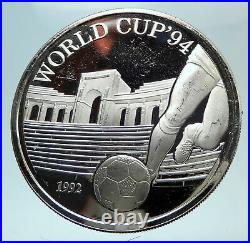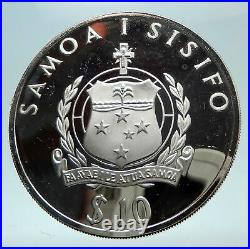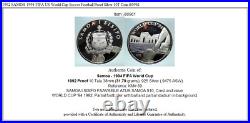



Item: i80961 Authentic Coin of. Samoa – 1994 FIFA World Cup 1992 Proof 10 Tala 38mm (31.79 grams). WORLD CUP’94 1992, Partial footballer with ball and partial stadium in background. The 1994 FIFA World Cup was the 15th edition of the FIFA World Cup, the world championship for men’s national soccer teams. It was hosted by the United States and took place from June 17 to July 17, 1994 at nine venues across the country. The United States was chosen as the host by FIFA on July 4, 1988. Despite the host nation’s lack of soccer tradition, the tournament was the most financially successful in World Cup history; aided by the high-capacity stadiums in the United States, it broke the World Cup average attendance record with more than 69,000 spectators per game, a mark that still stands. The total attendance of nearly 3.6 million for the final tournament remains the highest in World Cup history, despite the expansion of the competition from 24 to 32 teams (and from 52 to 64 games), which was first introduced at the 1998 World Cup and is the current format. Brazil won the tournament after beating Italy 3-2 in a penalty shoot-out at the Rose Bowl in Pasadena, California near Los Angeles, after the game had ended 0-0 after extra time. It was the first World Cup final to be decided on penalties. The victory made Brazil the first nation to win four World Cup titles. There were three new entrants in the tournament: Greece, Nigeria and Saudi Arabia plus two countries that were formed at the end of the Cold War: Russia, following the breakup of the Soviet Union, and for the first time since 1938, a newly reunified Germany took part in the tournament, following that country’s reunification in October 1990, which took place a few months after West Germany’s victory in the 1990 World Cup. /, officially the Independent State of Samoa Samoan: Malo Sa? Atasi o Samoa ; Samoan: Samoa, IPA:’sa? Moa and, until 4 July 1997, known as Western Samoa, is a country consisting of two main islands, Savai’i and Upolu, and four smaller islands. The capital city is Apia. The Lapita people discovered and settled the Samoan Islands around 3,500 years ago. They developed a unique Samoan language and Samoan cultural identity. Samoa is a unitary parliamentary democracy with eleven administrative divisions. The country is a member of the Commonwealth of Nations. Western Samoa was admitted to the United Nations on 15 December 1976. The entire island group, which includes American Samoa, was called “Navigator Islands” by European explorers before the 20th century because of the Samoans’ seafaring skills. After repeated efforts by the Samoan independence movement, the New Zealand Western Samoa Act 1961 of 24 November 1961 granted Samoa independence, effective on 1 January 1962, upon which the Trusteeship Agreement terminated. Samoa also signed a friendship treaty with New Zealand. Samoa, the first small-island country in the Pacific to become independent, joined the Commonwealth of Nations on 28 August 1970. While independence was achieved at the beginning of January, Samoa annually celebrates 1 June as its independence day. Travel writer Paul Theroux noted marked differences between the societies in Western Samoa and American Samoa in 1992. In 2002, New Zealand’s prime minister Helen Clark formally apologised for New Zealand’s role in the events of 1918 and 1929. New Zealand scientists have dated remains in Samoa to about 2900 years ago. These were found at a Lapita site at Mulifanua and the findings were published in 1974. The origins of the Samoans are closely studied in modern research about Polynesia in various scientific disciplines such as genetics, linguistics and anthropology. Scientific research is ongoing, although a number of different theories exist; including one proposing that the Samoans originated from Austronesian predecessors during the terminal eastward Lapita expansion period from Southeast Asia and Melanesia between 2,500 and 1,500 BCE. Intimate sociocultural and genetic ties were maintained between Samoa, Fiji, and Tonga, and the archaeological record supports oral tradition and native genealogies that indicate inter-island voyaging and intermarriage between pre-colonial Samoans, Fijians, and Tongans. Notable figures in Samoan history included the Tui Manu’a line and Queen Salamasina (15th century). Nafanua was a famous woman warrior who was deified in ancient Samoan religion. Contact with Europeans began in the early 18th century. Jacob Roggeveen, a Dutchman, was the first known European to sight the Samoan islands in 1722. This visit was followed by French explorer Louis-Antoine de Bougainville, who named them the Navigator Islands in 1768. Contact was limited before the 1830s, which is when English missionaries and traders began arriving. World-renowned expert numismatist, enthusiast, author and dealer in authentic ancient Greek, ancient Roman, ancient Byzantine, world coins & more. Ilya Zlobin is an independent individual who has a passion for coin collecting, research and understanding the importance of the historical context and significance all coins and objects represent. Send me a message about this and I can update your invoice should you want this method. Getting your order to you, quickly and securely is a top priority and is taken seriously here. Great care is taken in packaging and mailing every item securely and quickly. What is a certificate of authenticity and what guarantees do you give that the item is authentic? You will be very happy with what you get with the COA; a professional presentation of the coin, with all of the relevant information and a picture of the coin you saw in the listing. Additionally, the coin is inside it’s own protective coin flip (holder), with a 2×2 inch description of the coin matching the individual number on the COA. Whether your goal is to collect or give the item as a gift, coins presented like this could be more prized and valued higher than items that were not given such care and attention to. When should I leave feedback? Please don’t leave any negative feedbacks, as it happens sometimes that people rush to leave feedback before letting sufficient time for their order to arrive. The matter of fact is that any issues can be resolved, as reputation is most important to me. My goal is to provide superior products and quality of service. How and where do I learn more about collecting ancient coins? Visit the Guide on How to Use My Store. For on an overview about using my store, with additional information and links to all other parts of my store which may include educational information on topics you are looking for. This item is in the category “Coins & Paper Money\Coins: World\Australia & Oceania\South Pacific”. The seller is “highrating_lowprice” and is located in this country: US. This item can be shipped worldwide.
- Country/Region of Manufacture: Samoa
- Certification: Uncertified
- Year: 1994
- Circulated/Uncirculated: Uncirculated
- Composition: Silver
- Denomination: Denomination_in_description

